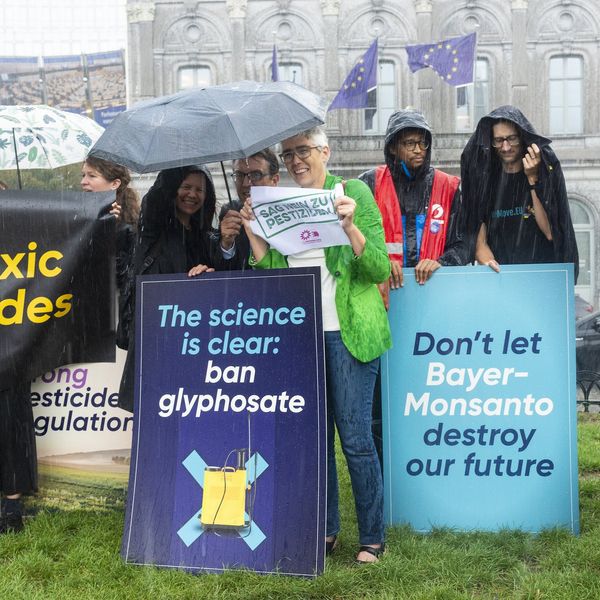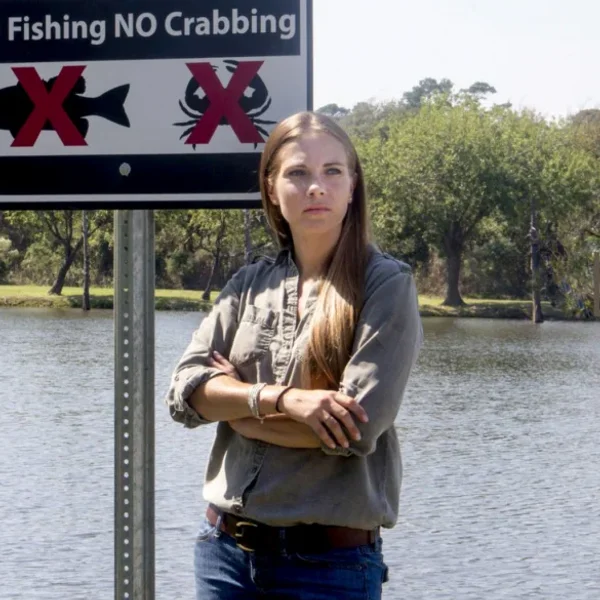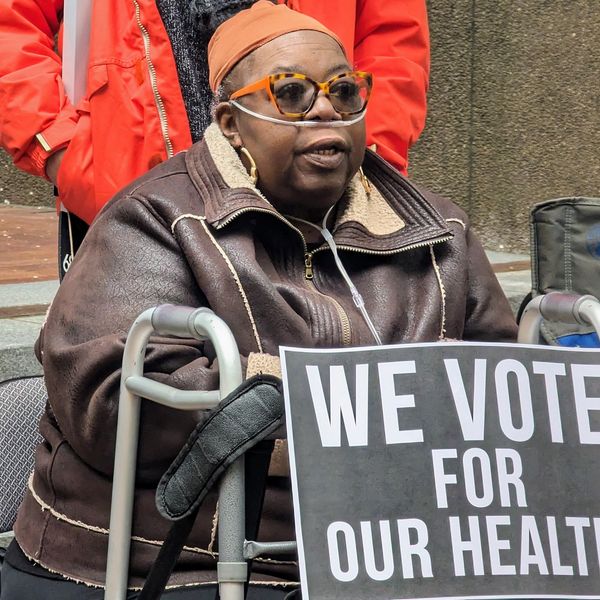This is part 4 of a 4-part investigation of the science surrounding the chemical BPA and the U.S. regulatory push to discredit independent evidence of harm while favoring pro-industry science despite significant shortcomings.
PITTSBURGH — A percussion of metal-on-metal echoes through the lab as empty food cans drop one by one off a conveyor belt and into rounded pockets of a rotating blue cogwheel.
As the cog circles counterclockwise, the can spins rapidly. Two spray guns blast a liquid lining inside before the can falls onto another conveyor belt and then shoots up a chute to a final belt that carries it down into a large curing oven.
These now freshly baked cans, their interiors a toasted brown, are part of a series of validation tests at the coatings company Valspar, recently acquired by Sherwin-Williams. For more than a decade, Valspar has worked to develop safe and effective replacements for food and beverage can linings historically made with bisphenol A.
Until about a decade ago, a layer of BPA-based epoxy about 20 times thinner than a human hair coated the inside of nearly all food and beverage cans. This shield excelled at preventing corrosion and, therefore, protecting us eaters and drinkers from deadly spoilage. But evidence has piled up that bits of the substance can leach from that lining and into soda, soups, Spam and sardines, among other canned products. And studies from academic laboratories show that BPA may mimic and mess with our hormones even at the tiniest of doses — increasing risks of cancer, diabetes and infertility, as well as derailing the normal development of a child's brain. That science suggests that our bodies are so sensitive to this compound that the use of BPA needs to be eliminated, not just reduced, to protect our health.
"The regulatory agencies are saying BPA is just fine," Tom Mallen, global director of packaging regulatory affairs at Sherwin-Williams, told EHN. "But there is a large voice contradicting that."
Related: Deciphering the real message about BPA
Despite this insistence from regulatory agencies of BPA's safety, some companies have been moving ahead with alternatives. With help from developments in green chemistry, and driven largely by consumer demand and policy-making outside of Washington, they are beginning to remove BPA and other endocrine-disrupting chemicals from store shelves. Still, progress is slow as the stakes are high. The global BPA market continues to grow and is predicted to surpass 7 million tons by the end of 2023. In addition to cans, the chemical is found in cash register receipts, dental sealants and the polycarbonate plastic used in reusable water bottles, among other products. Adding to the challenge: a safe and effective BPA replacement for one product may not be a suitable swap for others. And many of the alternatives that allow a manufacturer to proclaim a product "BPA free" show health effects that are just as bad, if not worse, than BPA. What will it take to ensure only our natural hormones are running the show in our bodies?
An investigation by EHN has uncovered details of a stand-off between academic scientists and federal regulators that intensified with the launch in 2012 of a multimillion-dollar government-led project called Consortium Linking Academic and Regulatory Insights on BPA Toxicity, or Clarity. Academics had increasingly voiced disagreement with the actions, or lack thereof, of the U.S. Food and Drug Administration with regard to the hormone imposter. The methods used by FDA regulators to assess the safety of chemicals, they have argued, remains decades behind the science. Clarity aims to help these critics and regulators reach a consensus on BPA's potential health harms, and to inform future testing and regulation of BPA and hundreds of other endocrine-disrupting chemicals including BPA replacements such as bisphenol S, or BPS.
So far, no such luck. As EHN detailed—via hundreds of emails obtained through Freedom of Information Act requests, along with dozens of studies and reports, and more than 50 conversations with scientists, regulators and other stakeholders—the FDA appears to have made up its mind on BPA before Clarity even began. "They already put a stake in the ground and they don't want to budge," Heather Patisaul, a professor of biology at North Carolina State University and a Clarity investigator, told EHN.
Here at Sherwin Williams' Packaging Global Technical Center in Pittsburgh, the tone is more positive. The company is among those actively pursuing BPA alternatives that won't disrupt our hormones. Mallen and four others sit around a table in the center's conference room, a short walk from the building with the Rube Goldberg-like can machinery. This room's walls display collections of consumer products that Valspar has coated over the decades, grouped by color of the brand's label.
There is the red assemblage: a metal bottle of Budweiser Select, a can of Campbell's Chunky BBQ seasoned pork, a Coca-Cola can. Further down the wall are shelves showcasing cans of San Pellegrino Limonata, Bumblebee solid white albacore tuna and Friskies Shreds with ocean whitefish and tuna — all with varying shades of yellow. Nearly every product displayed is lined with BPA. The substance has been an integral component of modern commerce for decades. Yet a major shift is underway for the half a billion or so food and beverage cans currently made each day in North America.
Over a lunch of sandwiches, chips and blue cans of water, Mallen goes on to describe his company's decision to not wait on regulators and to enlist the help of some of the staunchest BPA critics in the development of their next generation of BPA-free can linings. Starting in 2008, through a process they call "safety by design," Valspar went looking for a high-performing chemical compound that was not only less likely to leach from the inside of a can but also lacked the hormone-mimicking behavior of BPA or BPS. The winning compound: tetramethyl bisphenol F (TMBPF).
Academic scientists have tested the compound for a range of endocrine disruptive activities — effects that regulators do not typically consider in their safety assessments — and Valspar is now using TMBPF as the basis for ValPure V70, its newest family of can linings. The BPA-free epoxy lines those oven-cured cans, our blue cans of water and a small but increasing share of the food and beverage can market across the United States. Sherwin-Williams is applying for approval in the European Union.
"The industry's thinking was to not talk to critics, and to marginalize them," said Mallen. "We decided that wasn't a productive approach."
"This is the only time I've seen a company reach out to people with expertise." – Thomas Zoeller, UMass Amherst
Not kicking the can down the road
Thomas Zoeller, a biologist at the University of Massachusetts, Amherst, recalled his surprise when Valspar sought his collaboration. "This is the only time I've seen a company reach out to people with expertise," he told EHN, applauding Valspar's recognition of the modern toxicity testing techniques used by academics.
When evaluating a chemical that will come into contact with food, federal regulators generally look for obvious health effects such as changes in the weight of the brain and other organs in laboratory animals, or a fast-growing tumor. Academics search for more subtle changes that can be induced by small fluctuations in hormones such as attention deficit disorders or infertility. Such impacts may not even appear for years or until subsequent generations.
Not only was Zoeller free to use his modern scientific methods to evaluate TMBPF, but he was free to report whatever his science uncovered — even if it was unwelcome news for the company. "They were big on none of this work being private," he said. "I didn't have to sign an agreement."
Zoeller's collaboration with the government as part of the Clarity project, however, has not elicited the same warm feelings. "I don't think they have dealt with us in good faith," he said. An integrated Clarity report that pulls together findings from the government's study and studies conducted by participating academics is underway and expected to be completed by the end of 2019. Zoeller said that he doesn't anticipate the report will inspire any significant moves by the FDA to increase protections for public health.
The agency's website poses and answers the seemingly simple question: "Is BPA safe?" The agency goes on: "Yes. Based on FDA's ongoing safety review of scientific evidence, the available information continues to support the safety of BPA for the currently approved uses in food containers and packaging."
Linda Birnbaum, former director of the NIEHS and the National Toxicology Program, which are leading Clarity alongside the FDA, noted that knowledge of endocrine-disrupting chemicals and their actions has expanded in recent years — including just how a tiny dose of a chemical could affect the body even while a higher dose might do little or nothing. "I think we have to understand that science changes and advances and we need to be open to those changes," Birnbaum told EHN.
Related: A scientific stalemate leaves our hormones and health at risk
EHN's investigation has uncovered various signs of deficiencies in the FDA's science on BPA, including in its handling of Clarity, that seem to have stalled any chance of progress. There was the agency's insistence on aspects of Clarity's design that limited the study's robustness to detect health effects, and its premature public statements downplaying evidence of BPA's effects in the study. But while the FDA doesn't appear to be budging, industry responses to consumer concerns may signal a paradigm shift. Michael Hansen, a senior scientist for Consumer Reports, pointed to growing public awareness and demand for products free of BPA as well as phthalates, another family of endocrine-disrupting chemicals we encounter every day. Phthalates are used to soften the plastics in food packaging and as solvents in cosmetics, fragrances and other personal-care products.
"The market is starting to respond to that," he told EHN. "But more action has to be taken."
Most BPA replacements currently used in cash register receipts and plastics were created by rapidly tweaking the BPA molecule to form similar compounds such as BPS. The focus was on functionality, as opposed to looking at safety. And only after BPS was on the market did independent researchers began to find that it has endocrine-disrupting effects very similar to, or possibly even greater than, BPA.
A similar scenario has played out for some of BPA's other chemical cousins. A 2017 study found that six BPA substitutes—all used in products promoted as "BPA free"—had as much, if not more, of an estrogen-mimicking effect on human breast cancer cells as BPA.
And it's not only replacement bisphenols that are of concern. A bisphenol-free material called Tritan, developed by the company Eastman Chemical, is now widely used in plastic water bottles and food containers. The material is marketed as not having any hormone-related effects, yet some tests have found that stuff leaching from Tritan products — including products made for babies — could interfere with our hormones.
Kristin Parker, a spokesperson with Eastman, stated in an email to EHN that tests conducted by the company and by other third parties confirm that "Tritan is safe for its intended uses."
One of the studies that called Tritan's safety into question also found that some BPA-free plastic products didn't show any endocrine-disrupting properties. Those products contained BPA alternatives such as glycol-modified polyethylene terephthalate or cyclic olefin polymer.
But George Bittner, a neurobiologist at the University of Texas at Austin and lead author on the paper, is not among those expressing optimism. He did not identify what specific products contained those alternatives, noting that companies are constantly changing their formulations and may well be using different chemicals now. Bittner blamed a weak-to-nonexistent regulatory and consumer push on the lack of motivation for companies to prioritize getting endocrine activity out of their products.
Companies seem content with just "BPA-free." "It is like if Johnson & Johnson were selling a bandage that says it doesn't have Staph. aureus," said Bittner, who also founded CertiChemi, a company that tests products for endocrine activity, and PlastiPure, a company involved in making plastics without estrogenic chemicals. "That's nice. But how about Streptococcus or E. coli? And their response is only, 'There is no Staph. aureus.'"
"'BPA-free' is a fantastic marketing tool, but it is not evidence to the consumer of a safe product," Pat Hunt, a geneticist at Washington State University in Pullman, told EHN.
Of course, TMBPF, the basis for V70, is itself a bisphenol. This fact has made convincing people of its safety an uphill battle, according to Mallen. He underscored that Valspar has taken a novel approach, assessing the compound's safety alongside functionality throughout the entire process.
Some researchers seem to vet his stance that we may not need to immediately toss out every BPA relative. "Are all bisphenols bad? Maybe the answer is yes, until you can show certain ones are better," Joel Tickner, a pioneer in green chemistry at UMass Lowell, told EHN. Terrence Collins, another green chemist at Carnegie Mellon University, added that V70 is a "step in the right direction."
"They are providing a model for changing the chemical enterprise to deal more adequately with endocrine disruption," he said. Still, Collins told EHN that he is waiting on further data regarding the compound's potential endocrine-related activity: "I'm optimistic, but I want more convincing."
Can-do attitude
In a lab upstairs from the conference room, chemist Nusrah Hussain wears a pink and black headscarf and blue lab coat. She stands over a five-liter glass vessel, mixing an epoxy resin and other ingredients together to formulate a new polymer. If all goes well, the polymer could ultimately be used in a can coating for a new recipe of Campbell's Chunky soup.
Valspar is developing various versions of its ValPure V70 coating with specific characteristics for various foods and beverages. "Different end uses need different properties," Hussain told EHN. The expanding variety of products sold in cans today — from water to wine, even coffee and cannabis-infused alcoholic drinks — has added to the challenge.
Of course, cans are just one of the many sources of BPA in our everyday lives. And, unfortunately, V70 doesn't make a good polycarbonate for that array of other bisphenol-loaded plastics on the market, noted Collins. Beyond BPS and Tritan, few alternatives are in the works for plastics. A Korean research team is currently investigating a glucose-derivative bioplastic, for example.
Although, to date, bioplastics haven't proven to be a panacea. Martin Wagner, a biologist at the Norwegian University of Science and Technology, told EHN that he found "strong and abundant" toxic effects in the bioplastics he recently tested.
And bioplastics may provide lower quality at a higher cost.
Just how well a material serves its intended purpose, along with affordability, are requisite for replacements pushing out toxic predecessors. And that's a central challenge with all BPA substitutes.
The first beverage can was made back in 1935, shortly after the end of Prohibition. That can of red Krueger Beer was comprised of three steel pieces with a solvent-based PVC coating supplied by Valspar. But it wasn't long before BPA emerged as the superior substance for protecting the quality and flavor of whatever was inside a can. By the late 2000s, the majority of food and beverage cans were lined with BPA epoxy.
Consumer concern over BPA had begun escalating by that time — a result of accumulating research by academic scientists. In 2015, California responded by adding BPA to its Proposition 65 list of chemicals known to cause cancer or reproductive harm. That same year, France banned the use of BPA in all food packaging and containers. Because it's inefficient for manufacturers to use different products for different markets, industry was motivated to look for alternatives, Jeff Niederst, marketing director for beverage at Valspar, told EHN.
As makers of plastics looked to BPS and other chemical cousins, most can coating companies including Valspar initially sought non-bisphenol alternatives such as polyesters and acrylics. But those materials have significant performance limitations. Niederst wanted a better solution. He convinced his upper management that they had to look back to bisphenols, and work from the ground up to find one that did not have endocrine-disrupting characteristics.
Valspar scientists started by screening hundreds of molecules, searching for a bisphenol that would not physically fit into hormone receptors. One strong candidate, TMBPF, emerged. They then began working with environmental health advocates and academic scientists, including Zoeller, to determine how much of the compound might migrate from coated cans and make sure that whatever did make it into our bodies wouldn't scramble our hormones.
Although there are well-established tests for signs of a chemical causing cancer, there is "no widely accepted tests for androgen or estrogen activity and so forth," said Mallen. "We had to depend on people in academia to help educate us and guide us."
Scientists found that very little TMBPF could leach out of a can and into food: less than the 0.2 parts per billion that their testing method could even detect. Ana Soto, another Clarity participant and an endocrinologist at Tufts University, however, suggested that the more pertinent information came in testing endocrine activity of can extracts. It's not necessarily a single compound but rather a chemical cocktail that could leach out of a can lining. The additional substances may, too, have endocrine activity. So, she tested samples of the can extracts, for estrogenic activity. None.
Further tests, included in a paper published in October, looked to see if TMBPF could disrupt the delicate levels of androgen and aromatase, an enzyme that converts testosterone to estrogen, in the body. Some subtle anti-androgenic activity was seen at the highest dose studied; otherwise, all appeared clear.
"I don't eat anything canned," said Soto. "But I understand people do that. And a person who eats canned food is better off, in principle, with this one than the conventional one."
Bigger changes needed
Companies that are shifting away from BPA, such as Coca-Cola and Campbell's Soup, still referenced FDA's continued assurance of its safety. Mallen, too, was hesitant to suggest that more regulation is needed from the government on BPA. And he never said that low-dose BPA exposures actually posed a threat to public health. "The problem with the whole endocrine thing is there is no consensus," said Mallen. "We have to, as a society, get to a consensus on that first. Then the regulators would be able to do something with that."
Nevertheless, Valspar appears motivated to phase out BPA and avoid its equally troublesome cousins. The company is responding to consumer demand, much like the Campbell Soup Company. "Although the FDA has determined that BPA is safe to use in food packaging, we understand that some people would prefer to avoid it," Amanda Pisano, a spokesperson with Campbell's, told EHN in an email.
As more companies follow their lead, scientists hope they will also do the extra legwork to ensure any replacement is not just another endocrine disruptor. Rachel Simon, a researcher at the Lowell Center for Sustainable Production at UMass Lowell, is optimistic. "We're seeing companies move more quickly to trying to find innovative solutions. It doesn't matter what the driver is — regulatory or consumer demand," she told EHN. "Previously, people spent energy trying to fight about whether it is or it isn't safe. By focusing on innovation, we're able to find solutions faster than if trying to defend the legacy incumbent. I think we're seeing a shift."
Simon and Tickner are working to propel that shift, developing methods for chemists and toxicologists to evaluate potential substitutions for chemicals of concern, including the other thousand or so chemicals on the market that are believed to have endocrine-disrupting properties. Multiple strategies exist for creating chemical substitutes.
"You can look at less hazardous, structurally-similar molecules, or you could look at totally new molecules that achieve the same function, or you could make process changes that eliminate the need for a chemical," said Tickner. "Or you could just find another way to get the service that the chemical provides."
For example, there are efforts to bypass plastics in packaging, such as Tetra Brik, the paper-based liquid cartons used for various soups and beverages. A substitution toolbox has been expanding over the last several years. In 2013, a team of biologists, chemists and toxicologists developed a "Tiered Protocol for Endocrine Disruption" to help industrial scientists detect endocrine-disrupting tendencies early in the chemical development process. (Editor's note: Pete Myers, CEO and chief scientist of Environmental Health Sciences, was involved in the development of the protocol. He is also the founder of EHN, though the publication is editorially independent.)
Among the most useful tests to detect potential effects on the human endocrine system, according to the 23 authors, involves zebrafish. The tiny fish are fast to develop, transparent and absorb compounds through water. "It's a very powerful assay for signaling a lot of effects. And it's not expensive," said Collins, one of the authors of the protocol. "It is now possible to the highest levels of contemporary science to say whether or not you've got an endocrine disruptor." A separate nonprofit, Advancing Green Chemistry, helps connect people wanting to have chemicals tested and the experts to do the appropriate testing.
"Using this framework, chemists could refine chemicals and design toxicities out of those molecules," said Wagner of the protocol. "It takes a lot of time and resources, but eventually you end up with chemicals that you know right from the start are not toxic."
In addition to bioplastics, Wagner's recent paper analyzed the chemical mixtures in a range of plastics products and found that most showed some potential toxicity. His team found far more androgen-blocking effects across chemicals than the more well-known estrogenic impacts associated with BPA. The usual suspects, bisphenols and phthalates, played only a minor role. In fact, many of the suspect chemicals were unknown. Of the 1,400 substances they detected in a sample of plastic products, his team could identify only 260 compounds. "It's impossible for consumers to know what plastic contains what chemicals, and what's safe," he added. "It should be on the producers' responsibility to make sure their products are safe."
Wagner acknowledged that manufacturers are unlikely to start doing that by themselves given the added costs. Pressure is needed from the public and from regulators. "Industry has to strive to prevent the problem, but we will always need the regulatory part," added Soto. "The way the FDA does regulation has to change."
Tickner and Simon are among those arguing that the federal government should take advantage of the tools now available to build a regulatory framework for industry that includes the appropriate assays to detect low-dose endocrine-disrupting effects. Meanwhile, Europeans are already starting to employ assays very similar to those detailed in the tiered protocol. And they're creating incentives for its use. EU's Registration, Evaluation, Authorization and Restriction of Chemicals (REACH) regulation states that endocrine disruptors can be identified as substances of very high concern alongside chemicals known to cause cancer, mutations and toxicity to reproduction.
In July, the General Court of the European Union confirmed that BPA must be listed as such a substance, potentially subjecting the chemical to further regulation and restrictions under REACH. The implications could reach back to the U.S., much like how California's stricter rules impact markets across the country. "EU's regulations shape the world's regulations," said Simon.
Collins underscored the urgency, calling for a global movement with regard to endocrine disruptors that parallels the one for climate change. As machines continue to print cash register receipts, mold hard plastic bottles and spin metal cans, we remain part of a massive experiment with far greater implications than any designed by Rube Goldberg.
"It's just as bad as the climate in terms of its impact on living things," he said. "It's arguably faster acting, and hardly anyone knows about it."
Miss any of our "Exposed" series? See the entire four parts, as well as our comic "Clouded in Clarity."
- Europe heads toward safer chemicals - EHN ›
- BPA replacement linked to increased cardiovascular disease - EHN ›
- The hidden, potential cancer-causing, danger in woodworking and art supplies - EHN ›
- The hidden, potential cancer-causing, danger in woodworking and art supplies - EHN ›
- The most dangerous “sustainability dispositions” - EHN ›
- Bioplastics: sustainable solution or distraction from the plastic waste crisis? - EHN ›
- Federal tests 'dramatically' undercount BPA and other chemical exposures - EHN ›
- Bioplastics create a composting conundrum - EHN ›


























